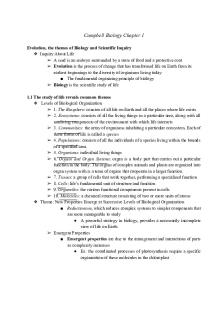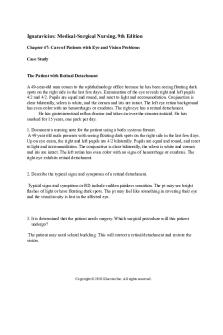Biology Chapter 47 Preclass PDF

| Title | Biology Chapter 47 Preclass |
|---|---|
| Author | Nini As |
| Course | Fund Of Bio Iii-Organismic Bio |
| Institution | St. John's University |
| Pages | 10 |
| File Size | 56.3 KB |
| File Type | |
| Total Downloads | 78 |
| Total Views | 157 |
Summary
These are the answers for the chapter 47 pre class assignment, this is for professor Jiyun Kim. If you have another professor this still may help you as additional notes. Chapter 47 is on Metabolism. ...
Description
Why do animals require nutrients? a. To provide energy for the production of ATP within cells b. To provide a source of materials for assembly of macromolecules All the bodily activities and chemical reactions in an organism that maintain life are called a. Metabolism The most important energy source during the absorptive state is: a. Glucose What happens to nutrients during the absorptive state? a. They enter the blood from the gastrointestinal tract. The phase in which the alimentary canal is empty of nutrients and the body's own stores must supply energy is called the what state? a. Post absorptive state Nutrients acquired by animals are used to assemble macromolecules or are used as fuel to generate energy in the form of blank that can be used to drive cellular reactions? a. ATP The metabolic rate of an organism is that rate at which the organism:
a. uses energy for bodily activities and chemical reactions During the postabsorptive state, the consumption of glucose by cells ______, and the consumption of fatty acids by cells ______ compared to the absorptive state. a. Decreases , increases
What happens during the postabsorptive state? a. The gastrointestinal tract is empty of nutrients. b. The body's own stores supply energy. Intestinal epithelial cells resynthesize digested lipids into ______ before they are absorbed into the blood. a. Triglycerides Carbohydrates are broken down into and then absorbed. a. Monosaccharides In fat cells, excess glucose is incorporated into ______ to be stored. a. triglycerides Cells require a constant supply of amino acids for the synthesis of . a. proteins During digestion, Blank 1are broken down into glucose and other monosaccharides, Blank 2, are broken down into amino acids, and Blank 3 are broken down into fatty acids and monoglycerides. a. Carbohydrates b. Proteinds c. Triglycerides What is NOT synthesised during the absorptive state? a. Glucose Mechanisms that help to maintain a constant blood glucose concentration in the postabsorptive state include: a. Gluconeogenesis b. Ketone production c. Glycogenolysis
d. Glucose sparing Why do cells require a constant supply of amino acids? a. Proteins are constantly being synthesized and broken down, but excess amino acids are converted into fatty acids. The breakdown of glycogen into glucose monomers is called: a. Glycogenolysis What is gluconeogenesis? a. The synthesis of new glucose from noncarbohydrate precursors Glycogenolysis, lipolysis, and ketone production help to maintain blood ______ levels during the postabsorptive state. a. Glucose In the postabsorptive state, glycogen and lipids are: a. Broken down Glycogenolysis, which occurs primarily in the blank, produces blank, which is released into the blood. a. Liver b. Glucose What is lipolysis? a. The breakdown of triglycerides into fatty acids and glycerol Gluconeogenesis occurs in the and results in the production of glucose that is secreted into the . a. Liver
b. Blood How does glucose sparing by other organs help the brain?
a. It prevents other organs from depleting the blood of glucose needed by the brain. During the postabsorptive state, the liver converts fatty acids into small compounds called blank , that provide an important energy source during prolonged fasting. a. Ketones Energy-producing molecules are maintained at homeostatic levels in the blood due to control by the and systems. a. Endocrine b. Nervous What type of molecule is insulin? a. Hormone Which of the following processes are upregulated during the absorptive state compared to the postabsorptive state? a. Triglyceride synthesis b. Glycogen synthesis The blood concentration of insulin increases during the blank state and decreases during the state. a. Absorptive b. Post absorptive The liver breaks down fatty acids during the postabsorptive state to synthesize: a. Ketones Put the steps involved in insulin signaling in the correct order, from first (on top) to last. 1. Insulin is released by pancreas
2. Insulin binds to receptor cells and stimulates a pathway 3. GLUTS increase 4. Glucose is taken by the cell 5. Blood glucose decreases What process is stimulated by insulin? a. Glucose transport in the cell How does insulin act to affect blood glucose levels? a. It binds to a cell-surface receptor, which stimulates a pathway that increases glucose transport into the cell, thus lowering levels in the blood. In insulin-responsive tissues like muscle and adipose tissue, when insulin is present, ______ in the cytosol that store glucose transporters fuse with the plasma membrane and make more glucose transporters available to transport glucose into the cell. a. Vesicles Put the events that occur after a meal in the correct order, from first to last. 1. 2. 3. 4. 5.
Blood glucose level increase Pancreas secretes insulin GLUTS are inserted Cells increase uptake of glucose Blood glucose level lowers
What stimulates the secretion of glucagon?
a. Low blood glucose
Energy created or destroyed a. Cannot The ______ in ATP store energy that can be used for biological activities.
a. Chemical bonds The amount of heat required to raise the temperature of one gram of water one degree Celsius is equal to
a. 1 calorie What is the basal metabolic rate? a. The metabolic rate of an animal at rest, in the postabsorptive state, and at a standard temperature An animal that is able to generate its own internal heat through its metabolism is called a(n) . a. Endotherm The chemical bonds in ATP that store cells can use for biological activities a. Energy The amount of oxygen consumed by an animal with a high BMR will be ______ the amount of oxygen consumed by an animal with a low BMR. a. Greater than Factors that can affect an animal's metabolic rate include: a. b. c. d.
Digestion Activity Sleep Body mass
The amount of energy an animal expends per gram of body mass is its - BMR. a. Mass specific Satiety is important for: a. short-term control of feeding How do eating and digesting food affect an animal's metabolic rate? a. They increase the metabolic rate.
Mass-specific BMR is useful because it allows scientists to compare the metabolic rates of animals that differ with respect to: a. Size In humans, long-term intake of food is controlled by emotional state, signaling molecules in the brain, and by . a. Hormones An increase in fat mass is expected to leptin secretion. a. Increase What part of the brain does leptin target? a. Hypothalamus Leptin appetite and metabolic rate. a. Decrease b. Increase Leptin is produced and secreted in proportion to: a. Fat mass Fasting blank leptin secretion a. Lowers What are the effects of leptin? a. It increases metabolic rate. b. It decreases appetite. A hormonal blank factor is believed to explain the balance between food intake and energy balance a. Satiety
The rare cases where leptin has successfully been used to treat obesity in humans involve individuals who have a mutation in the blank gene and do not produce the active hormone. a. Leptin Fasting for a long period of time results in: a. increased appetite b. decreased BMR What aspects of cellular structure and function are affected by temperature? a. Protein folding and function b. Rates of chemical reactions c. Plasma membrane structure The use of leptin in humans has had limited success in reducing obesity because:
a. most obese humans produce leptin but do not respond to it Match each term with the correct definition. a. b. c. d.
Radiation - the emission of electromagnetic waves from surface of an object Evaporation Convection - transfer of heat by movement of air or fluid next to the body Conduction - where the body loses or gains heat through the direct contact with cooler or warmer substances Heat loss to the environment can be reduced by ______ blood vessels near the skin surface. a. Constricting What is the purpose of countercurrent heat exchange? a. To retain heat to warm an animal's core
What is countercurrent heat exchange? a. The transfer of heat from warm blood to cold blood that is being returned to the body's core The production of body heat by the rapid contraction of muscles without locomotion is called thermogenesis. a. Shivering thermogenesis Shivering thermogenesis is a result of _______, and _______ is responsible for nonshivering thermogenesis. a. skeletal muscle contraction; brown adipose tissue In thermogenesis, the metabolic rate and heat production are increased without using muscle activity. a. Nonshivering thermogenesis Which of the following are health risks associated with excess body fat? a. Heart disease b. Cancer What measurement is used to assess body fat and health risks? a. BMI A man who is 178 cm tall has a BMI of 30. What is his approximate weight? a. 95 kg
● Recall that the liver converts fatty acids into ketones. ● Outline the mechanisms that maintain blood glucose concentration in the postabsorptive state. ● Recall that insulin promotes the transport of glucose from extracellular fluid into cells.
...
Similar Free PDFs

Biology Chapter 47 Preclass
- 10 Pages

Chapter 47 Practice Test
- 21 Pages

47 Antimicobacterianos
- 9 Pages

Biology: Chapter 10
- 5 Pages

Biology Chapter 1 Worksheets
- 15 Pages

Chapter 5 biology
- 6 Pages

Chapter 4, Biology Notes
- 17 Pages

Biology+Textbook+Chapter+17
- 28 Pages

Mastering Biology Chapter 17
- 21 Pages

Biology chapter 7 notes
- 2 Pages

Chapter 13 Biology Notes
- 4 Pages

Campbell Biology Chapter 1
- 8 Pages

Biology Chapter 6 questions
- 5 Pages

Mastering biology Chapter 17
- 43 Pages
Popular Institutions
- Tinajero National High School - Annex
- Politeknik Caltex Riau
- Yokohama City University
- SGT University
- University of Al-Qadisiyah
- Divine Word College of Vigan
- Techniek College Rotterdam
- Universidade de Santiago
- Universiti Teknologi MARA Cawangan Johor Kampus Pasir Gudang
- Poltekkes Kemenkes Yogyakarta
- Baguio City National High School
- Colegio san marcos
- preparatoria uno
- Centro de Bachillerato Tecnológico Industrial y de Servicios No. 107
- Dalian Maritime University
- Quang Trung Secondary School
- Colegio Tecnológico en Informática
- Corporación Regional de Educación Superior
- Grupo CEDVA
- Dar Al Uloom University
- Centro de Estudios Preuniversitarios de la Universidad Nacional de Ingeniería
- 上智大学
- Aakash International School, Nuna Majara
- San Felipe Neri Catholic School
- Kang Chiao International School - New Taipei City
- Misamis Occidental National High School
- Institución Educativa Escuela Normal Juan Ladrilleros
- Kolehiyo ng Pantukan
- Batanes State College
- Instituto Continental
- Sekolah Menengah Kejuruan Kesehatan Kaltara (Tarakan)
- Colegio de La Inmaculada Concepcion - Cebu

